- Home
- Painting Mixed Media
Painting Mixed Media Creates Awesome Paintings
Painting mixed media causes people to look in awe!
When I was doing street festivals in Florida, I started doing these paintings. People would stand and stare at the paintings because they were so different from regular watercolor paintings. They would just rave about them!
They would say, "What awesome paintings" - "How do you do it?" I never told. Since I'm not doing festivals now, why not share how to do them?
The paintings are a combination of watercolor and acrylic.
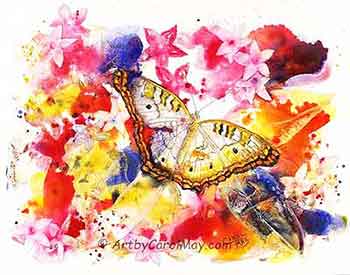 Mixed media, acrylic and watercolor
Mixed media, acrylic and watercolor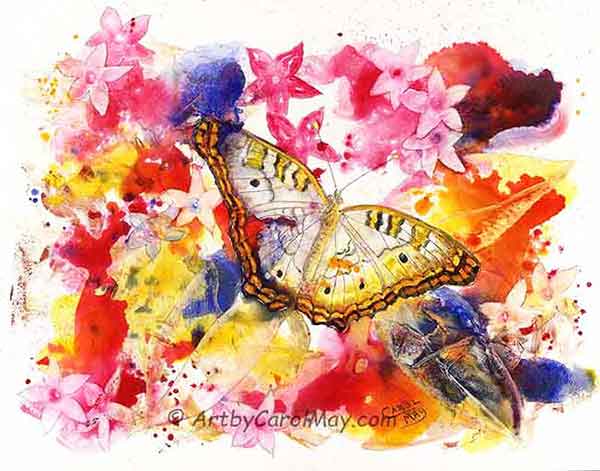 Mixed media, acrylic and watercolor
Mixed media, acrylic and watercolorPainting with Mixed Media Creates the Wonder
- You get unexpected and interesting texture that is not possible with just watercolor.
- Pouring the paint creates unusual lively color movement.
- The finished painting is framed without glass covering up the exciting texture and colors.
I had been doing butterfly paintings and it was getting tiresome doing all the detail. Plus, the glazing of traditional watercolors, takes a lot of time.
So to jazz it up, I decided to do some mixed media paintings of butterflies.
This White Peacock Butterfly is painted fairly realistic. Around the outside of the butterfly there is lot of color and the Penta flowers that butterflies love.
The extra color and texture created a free and lively painting.
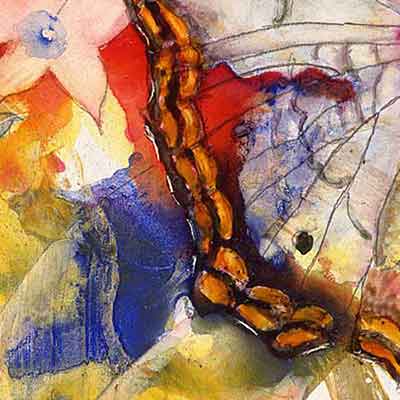 White Peacock detail-1
White Peacock detail-1Sometimes when you are pouring the paint, it flows into unexpected areas.
The red and blue flowed into the butterfly's wing. That is not its natural wing color. But it certainly adds interest to the painting.
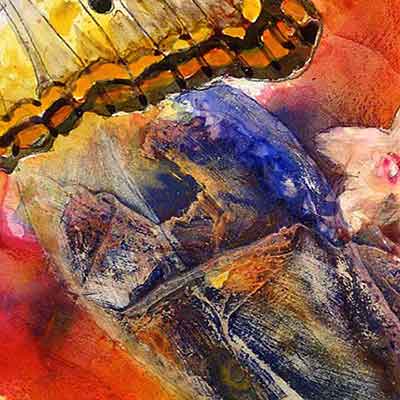 White Peacock detail-2
White Peacock detail-2The acrylic texture sometimes grabs the paint colors. Other times it stops the paint flow. It blocked the red from flowing.
The added interest and variety makes awesome paintings.
More Mixed Media Paintings
On the way to a show I stopped to show my neighbor the paintings I was taking to the show. When I pulled "Freedom's Light" out of the travel bag, she exclaimed, "What an awesome painting!"
She could feel the heart of the painting. That's what inspires me to paint. When the viewer feels the painting, you know it did a good job.
This is a prophetic painting. It shows the sailboats heading out of the storm toward the light.
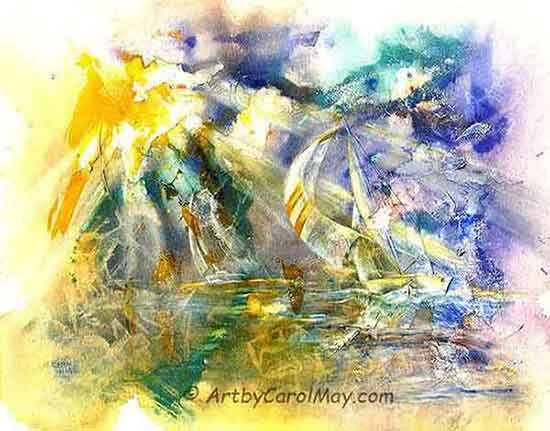 Sailboats heading out of the storm toward "Freedom's Light"
Sailboats heading out of the storm toward "Freedom's Light"The Exciting Texture Depicts the Stormy Weather
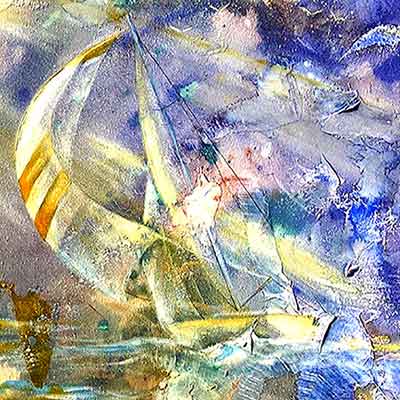 Detail of sailboat 1
Detail of sailboat 1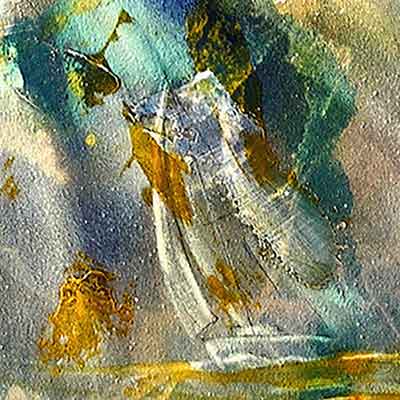 Detail of sailboat 2
Detail of sailboat 2Painting Mixed Media: How to Do It
What Materials I Use
Usually my watercolor paintings are on Ampersand's Aquabord. Aquabord has a texture similar to cold pressed watercolor paper. See why I switched to Aquabord.
- Use Ampersand Claybord because it has a smooth surface without texture. Claybord works well for this technique because the poured paint flows smoother than on Aquabord. Also, the smooth board creates a nice contrast to the rough texture of the acrylic.
- Tube of acrylic paint, white or your desired colors. Alternately, you may also use gesso, but it does not give the same texture as the thick acrylic paint.
- A palette knife to spread the acrylic.
- Watercolor paints of your desired colors
- Several small containers for mixing the watercolors for pouring.
- Paper towels for clean-up and to add more texture.
The Process of Painting Mixed Media
- Do a pencil drawing on the Claybord to give you a better idea of where to apply and not to apply the acrylic texture.
- Apply the acrylic paint on the board with a palette knife. Move it around to make texture. Leave parts of the board smooth with no acrylic.
Normally I use white acrylic, in Freedom's Light I used a combination of white on most of the painting and yellow for the light. - Let the acrylic paint dry completely.
- Pour on your watercolor paints. See how to pour watercolor.
The watercolor moves normally on the areas without the acrylic texture. The textured acrylic areas make the paint do interesting things. That's the beauty of painting mixed media. - Allow the poured paint to dry completely.
In Freedom's Light (go up) I used paper towels to blot the poured paint on some areas of the bottom of the painting to create additional texture. - Now paint your subject.
If the poured paint went over the areas of your highlights, you may use a fiber brush to remove some of the watercolor paint. The fiber brush is included the tool kit made specifically to use on Aquabord and Claybord panels. - Allow the painting to dry completely. Then spray it with several coats of a UV fixative spray.
The finished painting can then be framed without glass. The texture and colors display beautifully.
More Paintings of the Mixed Media Technique
This awesome mixed-media technique creates texture not normally possible with watercolor.
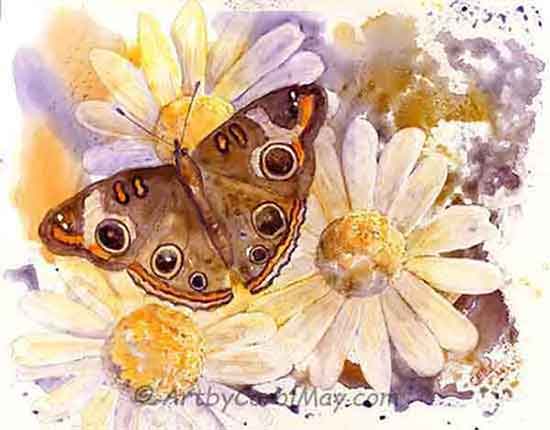 Buckeye Butterfly
Buckeye ButterflyFlowers, especially daisies are two my most favorite things. When I saw a Buckeye Butterfly on my daisy Chrysanthemums, I just knew they needed to be painted.
They cried out to be painted in a new and unusual way. Painting mixed media was the answer. It made a fresh and unusual painting with texture in the butterfly wings, the flower petals and the background.
Painting watercolor alone cannot create this amount of texture.
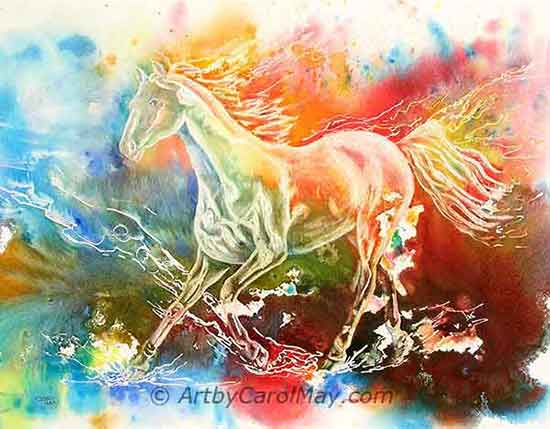 Freedom
FreedomPainting mixed media will give you a new freedom in your creations. The horse in this painting is running in his "Freedom" of this awesome technique.
After the horse was drawn on the painting support:
- This painting was done on Aquabord.
- White acrylic paint was applied.
- Frisket was applied to some areas like the flowing, splashing water and some of the mane and tail.
The painting is done with a limited color scheme of red, orange, yellow and blue. The browns and greens were created by the paint flowing and mixing.
Learn more about painting color schemes.
A fiber brush was used to pull out some of the highlights on the rump and other muscle areas on the horse.
The freedom and joy of doing this painting was awesome! You can do it!







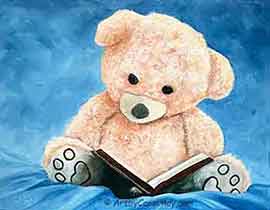 Are you eager to learn how to oil paint? What are the essential supplies for oil painting? What do we need for clean-up and how long do oil paintings take to dry? Learn the rules of oil painting and t…
Are you eager to learn how to oil paint? What are the essential supplies for oil painting? What do we need for clean-up and how long do oil paintings take to dry? Learn the rules of oil painting and t…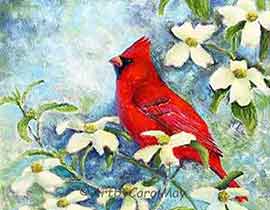 How do we create a focal point in art? Where do we put the focal point? How do we find the focus of an artwork? Should all paintings have a center of interest or can they have more than one? Learn fro…
How do we create a focal point in art? Where do we put the focal point? How do we find the focus of an artwork? Should all paintings have a center of interest or can they have more than one? Learn fro…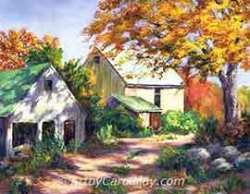 Art elements and principles appear over and over in good paintings. The elements and principles work together for us to create successful artwork. Art principles are the rules that govern how an artis…
Art elements and principles appear over and over in good paintings. The elements and principles work together for us to create successful artwork. Art principles are the rules that govern how an artis…